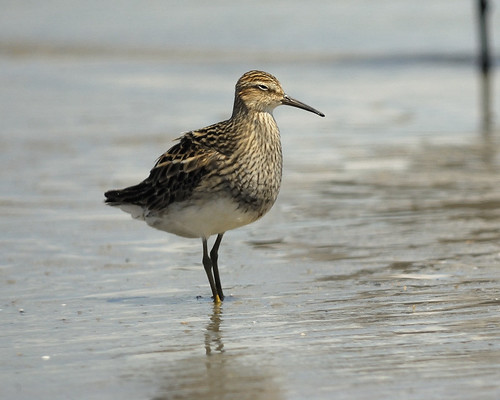tags: Pectoral Sandpiper, Calidris melanotos, birds, nature, Image of the Day
[Mystery bird] Pectoral Sandpiper, Calidris melanotos, photographed at the Texas City Dike, Texas. [I will identify this bird for you tomorrow]
Image: Joseph Kennedy, 3 September 2008 [larger view].
Nikon D200, Kowa 883 telescope TSN-PZ camera eyepiece 1/1000s f/8.0 at 1000.0mm iso400.
Read and learn to ID this species from a detailed analysis below the fold ...
Rick Wright, Managing Director of WINGS Birding Tours Worldwide, writes:
For 75 years, the Calidris sandpipers have labored under the reputation of being "difficult." How come?
Birding was invented when a bunch of smart people at the turn of the 20th century posed a breathtakingly simple and dazzlingly brilliant question: Which of the characters that we use to identify dead birds in the museum drawer are also visible on the living bird in the field? The preliminary answers to that question were compiled in a fine little book published in 1934, and for most of the rest of the century, the cutting edge of North American birding was the effort to refine that list of "field marks." As optics improved, as the odd new distinguishing character was published, as we learned to look closer, we got better. But a few groups remained elusive, among them the brown sandpipers, largely because the old museum characters translated so poorly into field experience.
That was last century. Over the last decade or so, a new bunch of smart people have been posing an even more wonderful question: Which characters visible on the living bird in the field aren't discernible in the museum drawer? The answers -- structure, shape, attitude, habit -- have revolutionized birding, and have transformed the task -- and the pleasure -- of birding from mechanical identification to recognition. And we've discovered, with the help of some fine books big and little, that even such traditionally "difficult" groups as Calidris sandpipers sort themselves out quite well in the 21st century.
Given a photo of the quality and clarity of this one, the old-fashioned, mechanical "field marks" approach works well enough. The odd junco-like underpart pattern of this bird is striking and readily visible; the gray of the breast is sharply divided from the clean white of the belly, and there are well-defined black streaks on each of the breast feathers. No bird but Pectoral Sandpiper shows that pattern -- making it a matter of an instant to pick out a skin in a drawer of miscellaneous sandpipers. We can confirm the identification with that other old "field mark" greatly beloved of beginning birders: foot color. Sure enough, the bird's right tarsus emerges just far enough into the sun to show us the greenish-yellow so characteristic of Pectoral Sandpiper. It feels like 1934 all over again!
But now imagine that it's the year 2008 (well, I suppose it really is), and imagine yourself out on a stinking hot day at a simply stinking shorebird puddle. And put this lovely bird a couple of hundred yards away in the heat shimmer, and let the sweat run into your eyes as you squint through the scope.... What do you see? A medium-sized brown sandpiper shaped like nothing else. The rear end is oddly attenuated, flat and long, but the body is almost grotesquely fat; the back is downright bulbous, and the breast threatens to pop as we look on. And atop it all is a ridiculously tiny head with an undersized bill. A generation ago, none of that would have been enough for most of us to identify the bird; but today, it's more than enough for the thoughtful birder to recognize it.
- Log in to post comments


Hmm... The analysis doesn't describe the bird in the photo, which appears to be a Pectoral Sandpiper.
Good eyes, Sheri!
r
sorry about that. i am having some problems with the site (annoying!).
Pectoral Sandpiper.
I don't recall if I've ever seen a Pectoral. But I doubt it. I'm pretty sure that clearly outlined white belly contrasted by the very dark, non-descript upper body stands out even at a great distance.
Baird's sandpiper?
Does anyone know what happens to these birds during/after a hurricane? Kennedy photographed many of these right where Ike hit.
Birds and weather is a huge and ultimately inscrutable topic. Here's a fine meditation on the matter:
http://aba.org/nab/v60n1p14.pdf
Another seagull? I'm afraid I'm so ignorant about ornithology, all birds are seagulls to me.
Pectoral sandpiper
Oh come now, Luger. Surely you can see that it might be a duck instead.
Here in Houston I hear word-of-mouth reports that Ike took out the Texas City dike.
Definitely a pectoral sandpiper fall plumage see Stokes pg 175 (1st edition 1996)
It's a Sleepy Sandpiper.
Good call, Smilodon. Definitely a Sleepy Sandpiper - no doubt tired and shagged out following a prolonged squawk.
Hmmmmm. Baird's Sandpiper or Pectoral Sandpiper